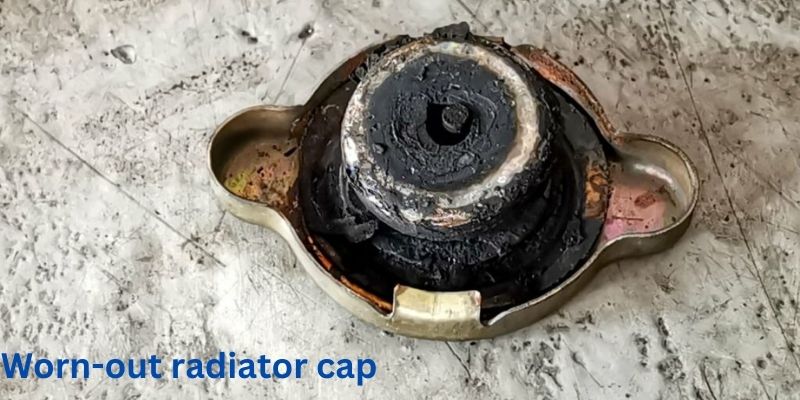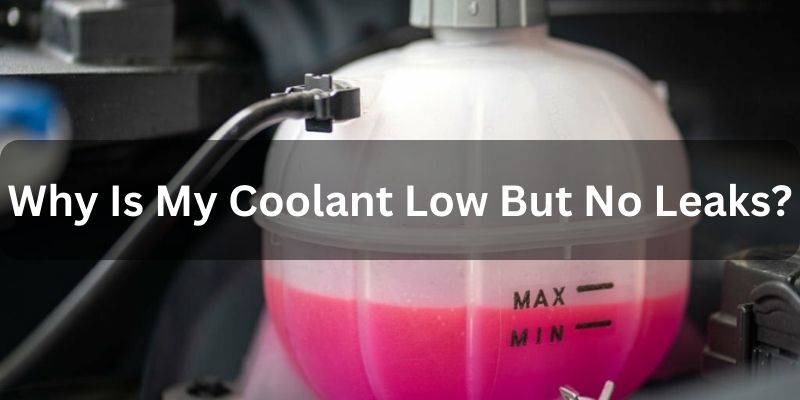Maintaining proper coolant levels is important for your vehicle’s long-term health and performance. One issue many vehicle owners encounter is gradually declining coolant levels caused by hard-to-detect internal leaks. Without a visible external source, it can be difficult to pinpoint the root cause.
However, ignoring the problem can lead to overheating and expensive repairs down the road. In this article, we will discuss the importance of coolant and explore some telltale signs that can indicate your levels are dropping without a seen leak.
In this article, I will solve your confusion about the mysteriously losing coolant but no leaks. You will learn all the causes of losing coolant no leak no overheating and fixing the coolant loss problem that is invisible.
Why is my coolant low but no leaks?
Many drivers face this confusing situation when their car is losing coolant but they are unable to find the source of the coolant leaking. Here are some potential reasons why your coolant level may be low without any visible leaks, along with brief explanations:
- Small internal cracks or holes
- Worn water pump/thermostat
- Porous radiator/heater core
- Blown head gasket
- Air pockets in the cooling system
In the next part, all the causes of coolant loss are explained widely.
Causes of Coolant Loss But No Leak
Internal Engine Leaks
The most likely cause of disappearing coolant is internal small leaks in the cooling system. These types of leaks occur inside the engine, radiator, heater core, or hoses where you can’t see the coolant escaping. Some common sources include:
- Blown head gasket – This failure allows coolant to leak into the engine cylinders or crankcase.
- Leaking cylinder head – Cracks or warped areas can allow coolant to seep.
- Faulty water pump – Leaks from the water pump seal or gasket may drip directly onto hot engine parts.
- Leaking heater core – The heater core inside the cabin can leak and evaporate without leaving traces.
- Pinhole leaks – Small openings in cooling system components allow coolant to slowly seep out over time.
Overflown coolant system
If too much coolant is added to the system, it can cause the coolant to overflow and spill out from the overflow reservoir or radiator neck. When this happens, the excess coolant is lost over time through evaporation or being washed away, rather than appearing as a visible leak.
Here’s how an overflowing system can lead to coolant loss without observing a leak:
- The cooling system has a specific maximum fill level it is designed for. Adding too much coolant pushes the level above this maximum mark.
- When the engine is running and heating up the coolant, the liquid expands slightly in volume. An overfilled system has nowhere for the expanded coolant to go.
- The pressure builds up until the excess coolant is forced up and out of the overflow reservoir or radiator neck opening.
- This spilled coolant may not drip or pool visibly since it is a one-time expulsion event during engine heating.
- Over time, the splashed-out coolant evaporates or gets blown or washed away by the elements and moving vehicles.
- Coolant is continuously lost this way, but it’s not observable as a direct constant leak from a crack or hole in the system.
- The only symptom is a gradual drop in the coolant level in the reservoir as it is being displaced without any leak being found.
Faulty EGR
A faulty exhaust gas recirculation (EGR) system is another potential cause of losing coolant without observing an identifiable leak. The EGR system helps reduce vehicle emissions by recycling a small portion of the exhaust gasses back into the engine intake.
The EGR cooler uses engine coolant to lower the temperatures of the recirculated exhaust gasses. Over time working against the high heat of the exhaust, the EGR cooler can develop cracks or leaks in its plates or valves.
Coolant is then able to mix with the exhaust gasses and exit through the tailpipe without leaving any telltale puddles under the vehicle. Carbon buildup is also known to clog EGR valves or block coolant flow inside coolers, causing them to warp or distort mounting surfaces until coolant finds a way out.
With the cooler directly exchanging heat between the engine and exhaust systems, any damage or failure can create direct pathways for coolant to vanish from sight. A low coolant check engine light may be the only symptom owners notice as the root cause of the disappearing coolant goes undetected.
Head gasket leak
A cracked gasket within the coolant system could also be a cause of losing coolant without a visible leak.
Gaskets are used as seals between different components of the cooling system that contain and circulate coolant. Common gasket locations include where the engine block meets the cylinder head, or where the radiator or coolant outlets interface with other parts.
Over time, constant heating and cooling of the engine can cause these gaskets to degrade. They may develop microcracks or begin to fail adhesively from the mounting surfaces.
A cracked gasket no longer forms a complete seal. This allows coolant to seep out in very small amounts that are not immediately obvious.
As coolant slowly escapes from the compromised gasket seal over an extended period, it can get blown or washed away through normal vehicle operation.
Gradually, the displaced coolant leads to an inexplicably dropping fluid level in the reservoir. However, a visual inspection does not reveal any active leaks or evidence of where the coolant is disappearing from inside the sealed cooling system.
Solution
Only replacement of the cracked gasket would fully stop the unseen coolant loss in this type of low-level leak scenario.
Also Read: Do You Add Coolant To Radiator Or Reservoir?
Air Pocket in the Cooling System
When coolant levels gradually decrease due to an imperceptible leak, air can enter the cooling system and become trapped. As coolant volume declines, it leaves space for air to be drawn in and form pockets.
Over time, these air bubbles accumulate, displace coolant, and cause the level to appear low.
From the reservoir, the coolant may appear low even if the drop is minor. This is because air compressibility causes pockets to rise and distort views of the true fluid level.
As air pockets grow larger with ongoing coolant loss, they can even interrupt full circulation and proper heat transfer. Their presence serves as an alert that, while no puddle is evident, cooling performance may be compromised by unseen coolant disappearing over long periods of engine use.
Solution
Bleeding the cooling system will eliminate all air pockets and show the actual coolant level in the reservoir.
Evaporation loss
The coolant is a mixture of water and glycol/ethylene glycol antifreeze.
The water component of the coolant is volatile and can evaporate at both high temperatures under the hood as well as at normal ambient temperatures. On hot days, the rates of evaporation will be higher.
Areas where spilled coolant may collect include:
- Engine surfaces near the cooling system
- Inner fender wells
- Bottom of the radiator grille
- Areas around the overflow reservoir
As the engine runs, hot air blowing through the front end helps the water in the coolant evaporate faster from these areas. Even when the engine is off, ambient heat and air circulation causes gradual evaporation.
Over weeks and months, a significant amount of water can dissipate through evaporation, leaving behind only the non-volatile glycol. Without replenishing the lost coolant, the overflowing system will continually lose coolant and water concentration.
Eventually, evaporation eats away enough of the spilled coolant that the only signs remaining are minor stains that provide no clues about the source or volume lost. By this point, the coolant level is low enough to trigger engine overheating concerns.
Worn-out radiator cap
A worn radiator cap cannot maintain proper system pressure like a new cap. When the engine heats the coolant, the pressure overwhelms the failing cap.
Rather than being directed up and sealed in the overflow tank as intended, the pressurized coolant escapes through microscopic leaks in the cap.
Due to the tiny leaks, only small amounts of coolant are lost over the long term. It evaporates or washes away without evident puddles.
Gradually, low coolant occurs as a result of the worn cap allowing repeated seepage.
Solution
Replacing the old radiator cap reseals the system to resolve the undetectable coolant loss caused by its inability to hold adequate pressure over time.

Symptoms of Losing Coolant No Leak
1. White Smoke from Hood
White smoke coming from the engine compartment or under the hood can possibly be a symptom of losing coolant through minor leaking that is not visible. As less coolant is available to efficiently circulate and regulate the engine’s temperature during operation, hot spots can develop within the metal engine blocks and cylinders.
Then, after shutting off the engine, this retained heat cannot fully dissipate right away since coolant flow has ceased. With lower coolant levels, pressure also builds up from the trapped heat under the hood.
As the pressurized, heated engine parts slowly cool down on their own, any remaining vaporized coolant may change from a liquid to a gas state.
This can cause steam to emerge from areas like the radiator cap, seams around manifold gaskets, or other small openings – revealing that the engine has overheated without the coolant system functioning properly due to an unseen loss of fluid over time.
2. Bad Engine Performance
A vehicle experiencing diminished engine performance could be a telltale sign of coolant loss issues, even if no evident leaks are found. As coolant quantity declines in the radiator, the engine may begin exhibiting rough operation, lack of power, or hesitation.
The cooling system acts critically to regulate engine temperature, and without adequate circulating coolant, components like the head gasket face undue heat stress. This can create inefficient combustion as hot spots and warping arise.
The engine ends up running hotter than design parameters, causing it to run rough or the car may stall more easily under load.
3. Low Coolant Check Light
Many modern vehicles have a sensor and warning light designed to alert the driver if coolant levels fall below normal. This low coolant warning light acts as an important symptom in detecting that coolant is disappearing from the system, even if the source isn’t outwardly apparent.
As an imperceptible leak slowly depletes coolant over long-term use, the fluid filling the coolant reservoir will decline to a point where it triggers the coolant level sensor.
Once this threshold is crossed, the dashboard panel will illuminate a low coolant warning light to inform the driver that the coolant reservoir is empty and needs to be replenished with the best compatible coolant.
4. Poor Heater Performance
As coolant levels gradually diminish from an imperceptible leak over time, there is less available to properly circulate through the heater core. As a result, passengers may notice that the vehicle’s heater is not blowing warm air as effectively as it should, even when set to high temperatures.
On cold days, the cabin may be more difficult to heat up. Over longer periods without coolant replenishment, the heater may even stop working entirely.
Weak or lack of heat from the vehicle’s vents, despite warm engine operation, serves as a sign of leaks of car coolant.
How to Diagnose and Fix Low Coolant Problems
Finding elusive coolant leaks often takes some careful diagnostic work. Here are some tips:
Inspect the Coolant Reservoir
Check the see-through plastic reservoir tank while the engine is cold. If the coolant level is low, inspect the tank cap, fittings, and seals for any signs of wetness or stains from minor leaks. Replace any worn or cracked caps and tighten fittings.
Perform a Coolant Pressure Test
This test pressurizes the cooling system to pinpoint any leaks. A special pump fits onto the radiator or reservoir to pump the system up to pressure. A gauge then monitors for any drops in pressure over time which indicate leaks.
Check for Exhaust in the Coolant
Extract a sample of coolant and inspect it. White milky sludge indicates coolant and oil mixing. White deposits mean exhaust gasses are entering the coolant from a head gasket or other internal leak.
Use Dye to Find Leaks
Adding special UV fluorescent dye to the coolant makes leaks glow brightly under a UV light. Run the engine to circulate the dyed coolant, then use the UV light to spot any escaping leaks.
Conduct a Cylinder leak-down test
This can find coolant entering the cylinders through a head gasket or head failures. Compressed air is pumped into each cylinder and the rate of leakage is measured. Higher than normal leakage confirms internal coolant leaks.
Inspect Visually for Stains
Look closely around the engine for dried white, crusty deposits that could indicate small coolant leaks have occurred. Coolant stains may be visible around cylinder heads, water pumps, hoses, gaskets, and fittings.
Preventing Low Coolant Levels
Maintaining proper coolant levels and looking for leaks early is the best way to avoid engine overheating or expensive repairs. Here are some tips:
- Check engine coolant levels frequently – Monthly checks are a good habit. Top it off as needed.
- Inspect hoses and fittings – Replace any cracked, swollen, or damaged hoses.
- Watch for leaks and stains – Clean up any visible coolant spills or stains immediately.
- Look for white exhaust smoke.
- Consider annual cooling system service – Flushing and refilling coolant prevents rust and removes contaminants.
- Fix minor leaks promptly – Don’t ignore seepage from hoses, caps, or gaskets.
Can coolant get low without a leak?
Yes, Coolant can get low without any leaking signs. There can be multiple signs of coolant level dropping but need to do a leak-down test to find coolant leaking. There are a few reasons why the coolant might slowly go missing without a big puddle.
The first cause behind the coolant level to drop without leak is internal engine leaking due to cracks in the engine compartment and the second reason can be a worn-out head gasket.
Is coolant getting low normal?
No, it’s not normal for your coolant levels to gradually get low over time without a visible leak.
Steadily decreasing coolant suggests an underlying problem like a small internal crack where coolant is slowly escaping without being noticed. Even tiny losses long-term can compromise the cooling system’s effectiveness.
Final Words
While external coolant leaks are obvious, internal engine and radiator issues can also cause invisible coolant loss over time. Microscopic cracks in the engine block, heads, or radiator core slowly weep coolant without visible puddling.
As components age, seals around the water pump or thermostat can also start leaking in small amounts. The only way to prevent coolant levels from dropping is to fix the underlying cause.
Repairs like radiator replacement or engine rebuild can seal leak points and restore proper cooling system performance. Regular checks and prompt repairs prevent far more costly damage down the road.

Hi, Michael Williams here. I have always loved everything with an engine. After earning my degree in automotive engineering, I spent 5 years testing vehicles for a major manufacturer in Illinois. Now I am using my technical skills to review the latest models online and help others troubleshoot their engine problems with effective solutions.
